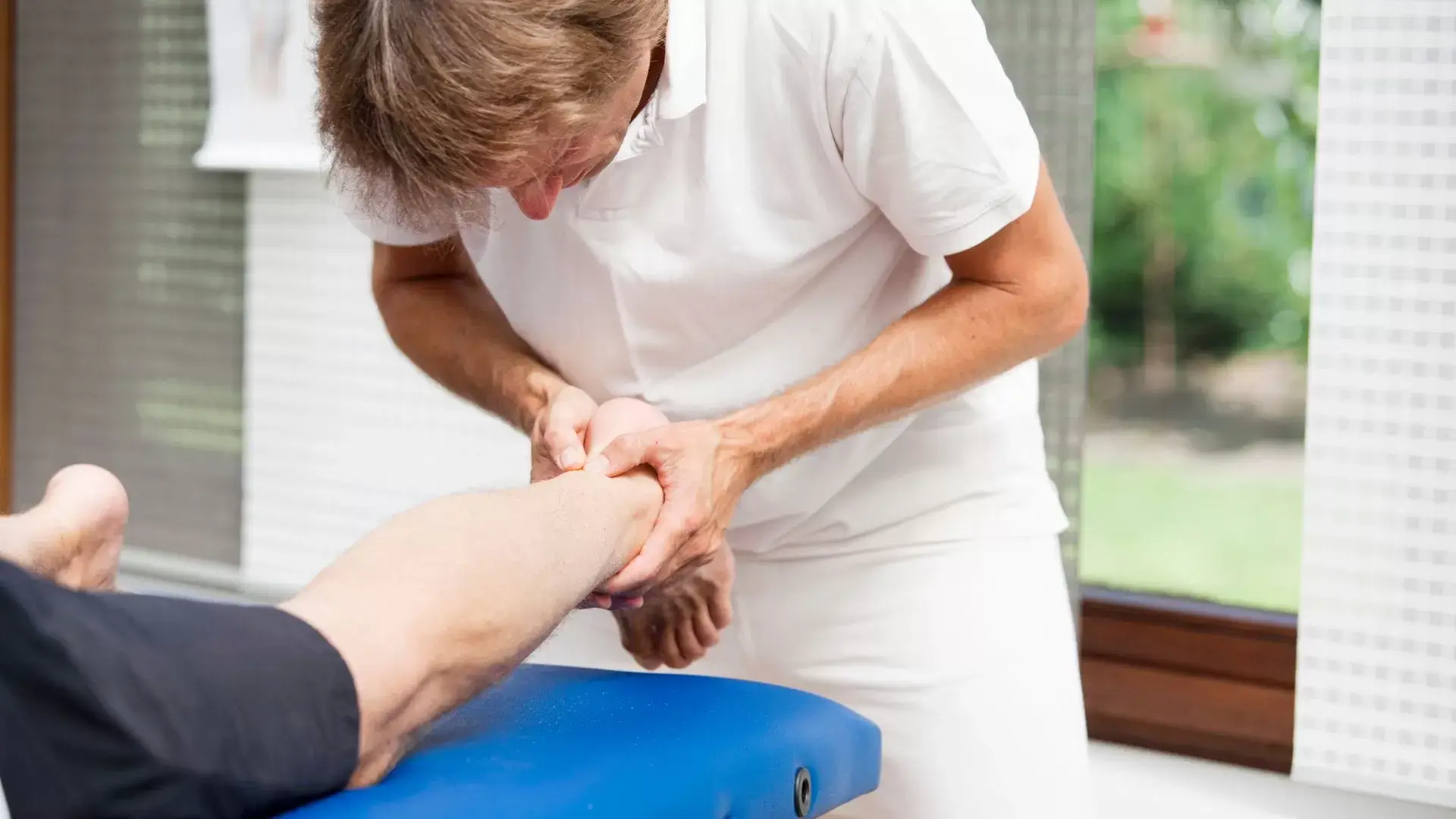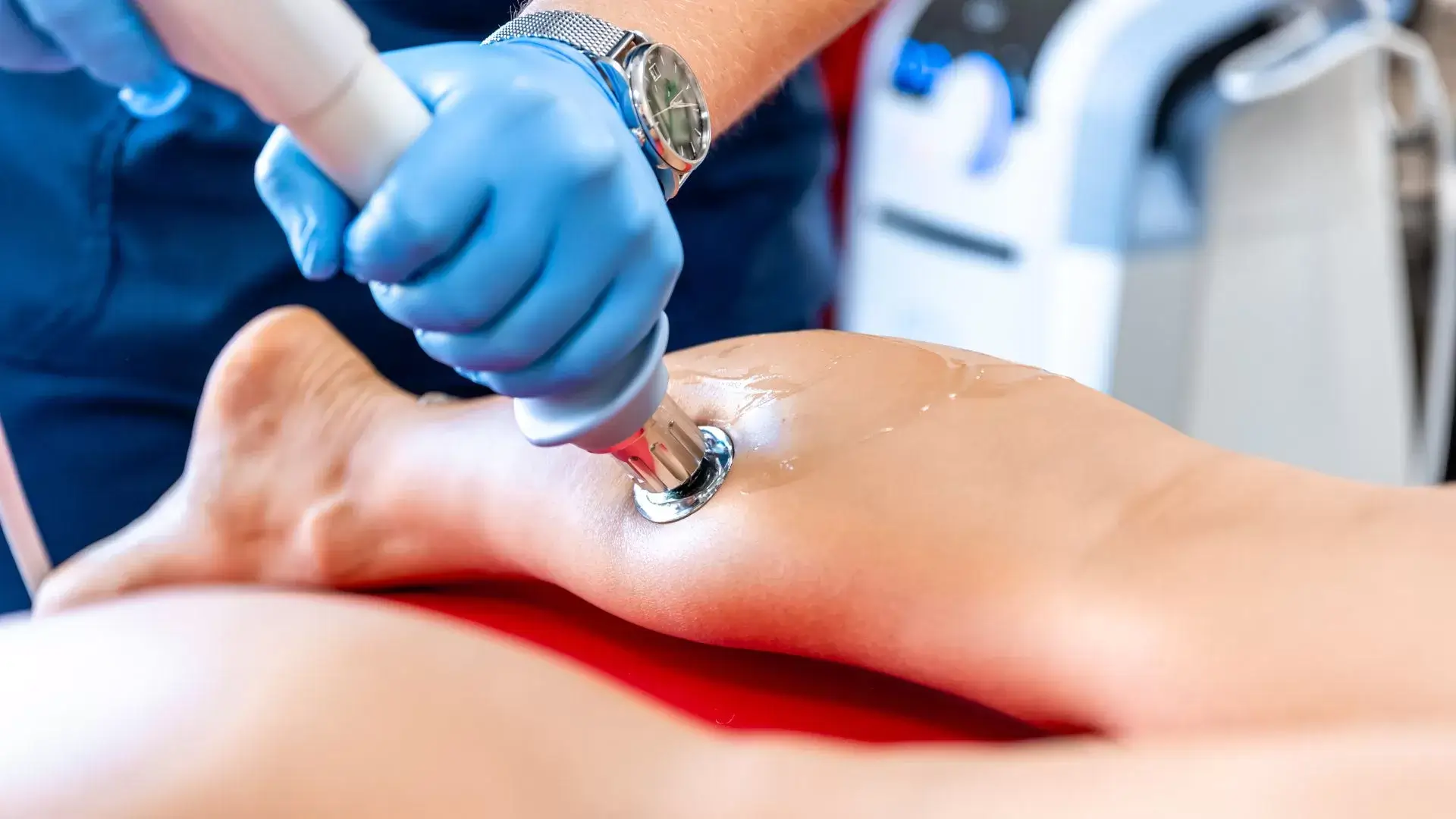Physiotherapy for Achilles Tendonitis in Mississauga is designed to help you overcome the challenges of this condition. We recognize how difficult Achilles tendonitis can be, and we’re here to help. Our specialized physiotherapy services focus on tailored treatment plans that address both the symptoms and underlying causes of your pain. By using a combination of manual therapy, targeted exercises, and corrective strategies, we aim to restore your mobility and strengthen the tendon. We also emphasize preventative measures to help avoid future injuries. Together, we can guide you through a safe return to your active lifestyle. There’s so much more to explore about how we can assist you on your recovery journey.

At Mississauga Physio Chiro Clinic, we provide extensive physiotherapy and chiropractic services tailored to support your recovery from Achilles tendonitis and other musculoskeletal conditions. We recognize how frustrating it can be to deal with inflammation and pain, especially if you’re an athlete or active individual. Our Best Physiotherapy & Chiropractic Clinic in Mississauga specializes in physical therapy techniques that address not only the symptoms but also the root causes of your sports injury.
Through a combination of manual therapy and targeted rehabilitation exercises, we focus on restoring function and strength to the affected area. We’ll also guide you through activity modification strategies that can help alleviate stress on your Achilles tendon, ensuring you’re on the right path to recovery.
Incorporating injury prevention into our treatment plans is essential. We emphasize the importance of a proper warm-up and cooldown routine to minimize the risk of future injuries. By working closely with you, we’ll develop a personalized approach that aligns with your lifestyle and fitness goals. Ultimately, our aim is to empower you to regain your mobility and return to the activities you love without pain or limitation. Together, we’ll help you achieve lasting relief and a healthier future.
Understanding the causes and contributing factors of Achilles tendonitis is essential for effective treatment and prevention, especially for those of us who are active or involved in sports. This condition often arises from an overuse injury, where repetitive stress on the Achilles tendon leads to inflammation and pain.
Several factors can contribute to the development of achilles tendinitis. For instance, improper footwear can exacerbate the issue, particularly if our shoes lack adequate support. Biomechanical issues, such as flat feet or high arches, can also play a significant role in how our feet absorb shock during activities. Additionally, muscle imbalances can contribute to the strain on our Achilles tendon; tight calf muscles may place undue stress, while weak calf muscles can fail to provide the necessary support.
When we experience pain or stiffness along the back of the heel or in the calf, it could signal the onset of Achilles tendonitis, especially after increased activity or exercise. This condition, often referred to as Achilles tendinopathy, can manifest in various ways. We may notice heel pain that worsens with activity and tenderness along the tendon.
In the mornings, we might struggle with morning stiffness, making it difficult to get out of bed. As we engage in daily activities, we could experience limited ankle mobility and swelling around the tendon. The discomfort can be particularly pronounced when we attempt to perform dorsiflexion, such as when walking uphill or climbing stairs, leading to increased pain with activity.
Tendon thickening may also occur, which is a physical sign of the condition. If we pay attention to these symptoms, we can recognize when it’s time to seek help. Understanding the signs of Achilles tendonitis allows us to address our discomfort early, potentially preventing further complications. So, if we identify these symptoms, we should consider reaching out for professional guidance to guarantee proper care and management.
Physiotherapy plays an essential role in our recovery from Achilles tendonitis, offering targeted strategies to alleviate pain and restore function. When we’re dealing with an Achilles tendon injury, our physiotherapist tailors a thorough treatment plan that includes both stretching exercises and strengthening exercises. These exercises help improve flexibility and build resilience in the tendon, promoting healing.
Incorporating massage therapy into our routine can also be beneficial, as it aids in reducing muscle tension and improving blood flow to the affected area. We often find that alternating ice therapy and heat therapy helps manage inflammation and promotes recovery. Ice therapy can reduce swelling right after activity, while heat therapy can ease tightness when we’re preparing to exercise.
Our physiotherapist may also recommend orthotics to provide the necessary support and alignment for our feet, which can prevent further strain on the Achilles tendon. Load management is vital, as it allows us to gradually increase our activity levels without risking re-injury. By adhering to this structured approach, we can greatly reduce our recovery time and safely return to sport, ensuring we’re stronger and more resilient than before.

Utilizing hands-on manual therapy can considerably enhance our healing process for Achilles tendon injuries by promoting tissue mobility and reducing pain. This approach becomes essential when dealing with conditions like Achilles tendon rupture, tear, or degeneration. Techniques such as deep tissue massage and cross-friction massage can alleviate tightness and improve blood flow, facilitating recovery.
In our sessions, we often incorporate eccentric loading exercises to strengthen the tendon while minimizing stress, particularly for those who participate in high-impact activities. It’s also important to combine manual therapy with other modalities, such as anti-inflammatory medications or platelet-rich plasma (PRP) therapy, to optimize healing and reduce inflammation.
While most patients respond well to conservative treatments, we must remain aware that surgical intervention may be necessary for severe cases. By addressing the injury through hands-on techniques, we can effectively guide our patients on their path to recovery, ensuring they regain strength and function. Together, we’ll navigate the challenges of Achilles tendonitis, empowering each individual to return to their desired activities with confidence and resilience.
Incorporating key stretching and strengthening exercises into our treatment plan can greatly support the recovery and ongoing health of the Achilles tendon. These exercises help alleviate calf tightness and stiffness, reducing the risk of an Achilles tendon strain or calf strain.
We often begin with stretching exercises aimed at improving flexibility in both the calf muscles and the Achilles tendon itself. Techniques such as the calf stretch and towel stretch can be beneficial. Following these, we introduce strengthening exercises like heel raises and eccentric heel drops to enhance the tendon’s resilience and support proper gait mechanics.
Additionally, we may utilize therapies like ultrasound therapy or shockwave therapy to complement our exercise regimen, promoting healing and reducing discomfort. It is crucial to incorporate a proper cool-down after these activities to prevent stiffness and maintain flexibility.
Through consistent practice of these exercises, we can address any underlying issues and create a solid foundation for our Achilles tendon health. By focusing on these key components, we actively contribute to our recovery journey, minimizing the risk of future injuries.
Identifying and correcting biomechanical issues can substantially reduce stress on the Achilles tendon, paving the way for more effective recovery and injury prevention. We often encounter patients who experience microtears in their tendons due to improper alignment, often exacerbated by factors like excessive pronation or supination during activities like running.
To address these challenges, we might recommend interventions such as heel lifts or arch supports, which can help optimize foot positioning and reduce strain on the tendon. Ankle braces can also provide additional stability, ensuring that the foot maintains its proper alignment while engaging in physical activities.
We utilize various taping techniques to support the tendon without restricting movement, allowing for continued activity while promoting healing. In more persistent cases, therapeutic options like dry needling and electrotherapy can alleviate pain and improve tissue function, thereby enhancing recovery.
Shockwave and ultrasound therapy are two effective modalities we can employ to enhance tendon recovery in patients suffering from Achilles tendonitis. These therapies play an essential role in our rehabilitation approach, as they promote healing and alleviate pain. Shockwave therapy utilizes acoustic waves to stimulate blood flow and metabolic activity in the affected area, which can greatly improve tendon recovery.
Ultrasound therapy, on the other hand, uses sound waves to penetrate tissues, promoting tissue repair and reducing inflammation. Together, these treatments are integrated within our physiotherapy programs to optimize recovery outcomes.
We often emphasize the importance of combining these therapies with exercise therapy, as it helps strengthen the tendon and improve flexibility. By utilizing regenerative medicine techniques, we can further enhance the healing process, potentially reducing the need for minimally invasive surgery.
In our practice, we focus on personalized pain management strategies, ensuring that each patient receives the most effective treatment tailored to their needs. By integrating shockwave and ultrasound therapy into our rehabilitation protocols, we’re committed to helping our patients regain mobility and return to their daily activities as quickly as possible.

To complement our approach in enhancing tendon recovery, we often utilize electrotherapy and TENS (Transcutaneous Electrical Nerve Stimulation) treatment to effectively manage pain associated with Achilles tendonitis. These modalities provide a non-invasive means of alleviating posterior heel pain, which can be quite debilitating for our clients.
Electrotherapy works by delivering electrical impulses to the affected area, promoting blood flow and reducing inflammation. This can be particularly beneficial for patients experiencing symptoms like nodules or crepitus in the tendon. TENS treatment, on the other hand, focuses on interrupting pain signals sent to the brain, offering immediate relief during sessions.
While we encourage the use of TENS and electrotherapy as part of a thorough physiotherapy plan, we also recognize that some clients may require additional pain management strategies, such as NSAIDs or corticosteroid injections, for more severe cases. Our goal is to tailor a treatment plan that not only addresses pain but also encourages healing and functionality. By integrating these techniques, we aim to improve our clients’ overall quality of life and support their journey towards recovery from Achilles tendonitis.
Selecting the right footwear and orthotics is vital for providing the necessary support to our Achilles tendons during recovery. When we’re dealing with conditions like Achilles tendonitis, improper footwear can exacerbate our symptoms and hinder healing. We should look for shoes that offer good arch support, cushioning, and a comfortable fit to help alleviate strain on our tendons.
If we’ve experienced a jumping injury or undergone procedures like Achilles tendon debridement or repair, custom orthotics may be beneficial. These devices can help in redistributing pressure away from the affected area, promoting better alignment and support.
We can consult with a physiotherapist or a podiatrist at locations like 1834 Lakeshore Rd W unit 6C, Mississauga, ON L5J 1J7, or reach them. They can provide personalized recommendations on footwear and orthotics tailored to our specific needs.
Incorporating proper footwear and orthotics into our rehabilitation plan, along with treatments like TENS therapy, can greatly enhance our recovery process. Remember, investing in the right support is a vital step towards regaining our mobility and preventing future injuries.
In addition to choosing the right footwear and orthotics, utilizing bracing and taping methods can greatly enhance stability and help prevent further injury to the Achilles tendon during our recovery process. These techniques provide additional support by restricting excessive movement, which is vital as we heal.
Bracing can involve the use of specialized ankle braces designed to stabilize the ankle joint. This support can help us regain confidence in our movements, allowing us to gradually return to our regular activities without fear of re-injury. It’s important to make certain that the brace fits well and doesn’t restrict circulation.
Taping, on the other hand, can be an effective and versatile method. By applying athletic tape, we can create a supportive structure around the Achilles tendon. This technique not only offers stability but also aids in proprioception, helping us be more aware of our foot and ankle positions.
As we explore these options, we should consult with our physiotherapist to determine the best approach tailored to our specific needs. By incorporating bracing and taping into our recovery plan, we can enhance our stability and pave the way for a successful return to activity.
Managing pain effectively during our recovery from Achilles tendonitis often involves a combination of ice, heat, and anti-inflammatory treatments. Each method plays a critical role in alleviating discomfort and promoting healing, allowing us to regain our mobility and strength.
Initially, applying ice can help reduce swelling and numb the pain. We should aim to ice the affected area for about 15-20 minutes several times a day, especially after activity. This approach helps to mitigate inflammation and can be particularly beneficial in the early stages of our recovery.
As we progress, incorporating heat can aid in relaxing the muscles and improving blood circulation. We can use a warm towel or heating pad for 15-20 minutes, making sure we avoid excessive heat that could exacerbate inflammation.
In addition, non-steroidal anti-inflammatory drugs (NSAIDs), such as ibuprofen or naproxen, can provide additional relief from pain and swelling. However, it’s important to consult with a healthcare professional before starting any medication to confirm it’s appropriate for our situation.
After addressing pain management with ice, heat, and anti-inflammatory treatments, we now turn our attention to the significant phase of post-surgical rehabilitation following an Achilles tendon repair. This rehabilitation is vital for restoring strength, mobility, and function in the affected area.
In the initial weeks post-surgery, our focus will be on gentle range-of-motion exercises to prevent stiffness and promote healing. We’ll gradually introduce isometric exercises to maintain muscle strength without placing undue stress on the tendon. As we progress, we’ll incorporate more dynamic movements, emphasizing controlled exercises to rebuild strength safely.
Throughout this process, it’s important to listen to our bodies. We’ll monitor pain levels and swelling closely and adjust our rehabilitation plan as needed. Incorporating physical therapy sessions will provide us with expert guidance, ensuring that we’re on the right path to recovery.
As we shift to weight-bearing activities, we’ll prioritize proper gait mechanics to avoid compensatory patterns that could lead to further issues. By following a structured rehabilitation program, we can effectively restore function and minimize the risk of complications, ultimately paving the way for a successful return to our desired activities.
How can we effectively implement proactive strategies to prevent the recurrence of Achilles tendonitis? First, we need to focus on flexibility and strength training. Regular stretching of the calf muscles and Achilles tendon helps maintain flexibility, while targeted strengthening exercises can bolster the surrounding muscle groups, reducing strain on the tendon itself.
Next, we should pay close attention to our footwear. Wearing proper shoes that provide adequate support and cushioning is vital, especially during physical activities. We can also consider the surfaces we run or walk on, opting for softer ground when possible to minimize impact.
Gradual progression in our training routines is essential. By increasing intensity, duration, and frequency of activities slowly, we can allow our bodies to adapt without overloading the tendon. Incorporating rest days into our schedules will also give our bodies time to recover.
Lastly, regular check-ins with a physiotherapist can help us stay on track. They can assess our form and provide personalized advice tailored to our specific needs. By adopting these proactive strategies, we can greatly reduce the risk of Achilles tendonitis recurrence and enjoy a healthier, more active lifestyle.
Returning to sports and everyday activities requires a careful, gradual approach to guarantee we don’t exacerbate any lingering issues related to Achilles tendonitis. It’s essential to listen to our bodies and recognize any signs of discomfort or pain. Starting with low-impact activities, like swimming or cycling, can help us maintain fitness while minimizing stress on the tendon.
As we progress, we can gradually reintroduce weight-bearing exercises and sports-specific movements. It’s important to focus on building strength in the calf muscles and improving flexibility. Incorporating targeted stretching and strengthening exercises into our routine can enhance tendon resilience and support recovery.
We should also pay attention to our footwear, ensuring that we wear supportive shoes that provide adequate cushioning. This can greatly reduce strain on the Achilles tendon when we return to more intense activities.
Seeking expert physiotherapy care for Achilles tendonitis in Mississauga can greatly enhance our recovery journey and help us regain strength and mobility. By working with experienced physiotherapists, we can receive tailored treatment plans that address our specific needs and conditions. These professionals utilize a combination of manual therapy, exercise prescription, and education to promote healing and prevent further injury.
During our sessions, therapists assess our range of motion, strength, and functional abilities, allowing them to identify underlying issues contributing to our tendonitis. This individualized approach guarantees that we’re not just treating symptoms but addressing the root cause of our discomfort. Additionally, physiotherapists can educate us on proper biomechanics and techniques to minimize strain on the Achilles tendon as we return to our activities.
In addition to physical treatment, emotional support plays an essential role in our recovery. A compassionate physiotherapist can help us navigate the frustrations that often accompany injuries, empowering us to stay motivated and focused on our goals. By seeking expert care, we’re not only investing in our physical health but also in our overall well-being, guaranteeing a safer and more effective return to our daily lives and sports. Contact us today!
Mississauga is a vibrant city that consistently offers a rich blend of cultural diversity, recreational opportunities, and community resources, making it an ideal place for residents and visitors alike. As we explore this dynamic city, we notice how its multicultural fabric fosters an inclusive environment where everyone can feel at home.
With numerous parks, trails, and sports facilities, Mississauga encourages an active lifestyle, which is essential for those of us dealing with health issues like Achilles tendonitis. We can take advantage of the city’s commitment to wellness by participating in various fitness programs and events designed to promote physical health.
Moreover, Mississauga’s healthcare resources, including specialized physiotherapy clinics, provide thorough care tailored to our needs. The city’s emphasis on education and community engagement means we have access to valuable information and support networks, enabling us to manage our conditions effectively.
In essence, living in Mississauga not only enriches our lives through cultural experiences and recreational activities but also empowers us to prioritize our health and well-being. We’re fortunate to reside in a city that values both community and individual wellness.

When we consider recovery from Achilles tendonitis, it typically takes anywhere from a few weeks to several months, depending on the severity of the condition and our commitment to rehabilitation. We must remember that each case is unique; factors like age, activity level, and adherence to treatment can influence our recovery timeline. By staying patient and following a well-structured plan, we can effectively manage our recovery and return to our activities stronger.
When we consider the specific risk factors for athletes, it’s crucial to recognize that overuse, inadequate warm-up, and improper footwear can greatly contribute to injuries. We’ve seen that athletes often push their limits without proper conditioning or recovery time, increasing their vulnerability. Additionally, factors like age, training intensity, and surface type can also play a role in susceptibility to injuries. Understanding these risks helps us take proactive measures to stay safe and healthy.
During our first physiotherapy appointment, we can expect a thorough assessment of our condition. The physiotherapist will ask about our medical history, symptoms, and daily activities. They’ll likely perform physical tests to evaluate our strength and range of motion. We should also be prepared to discuss our goals for treatment. Overall, it’s a collaborative process, allowing us to understand our condition better and set a tailored plan moving forward.
When it comes to exercising during treatment, we need to approach it with care. We’ll likely be advised to modify our activities based on our specific condition and pain levels. It’s important to communicate openly with our therapist about what exercises we’re comfortable doing. By focusing on low-impact activities, we can maintain our fitness without aggravating the injury. Staying active can actually support our recovery, as long as we listen to our bodies.
When it comes to the frequency of physiotherapy sessions for ideal recovery, we typically recommend attending sessions two to three times a week. This allows us to closely monitor progress and adjust treatment as needed. However, each individual’s needs can vary, so we should always communicate openly about how we’re feeling and any concerns we have. Our therapist will work with us to create a personalized plan that supports our unique recovery journey.
Reach out to us today to book an appointment or learn more about our services. Our friendly team is here to answer your questions and help you take the first step toward improved health and wellness.
(647) 372-1209

At our “Mississauga Physio Chiro Clinic”, we are dedicated to providing personalized care that addresses the root cause of your discomfort. With a team of experienced physiotherapists and chiropractors, we focus on restoring your mobility, relieving pain, and enhancing your overall well-being.